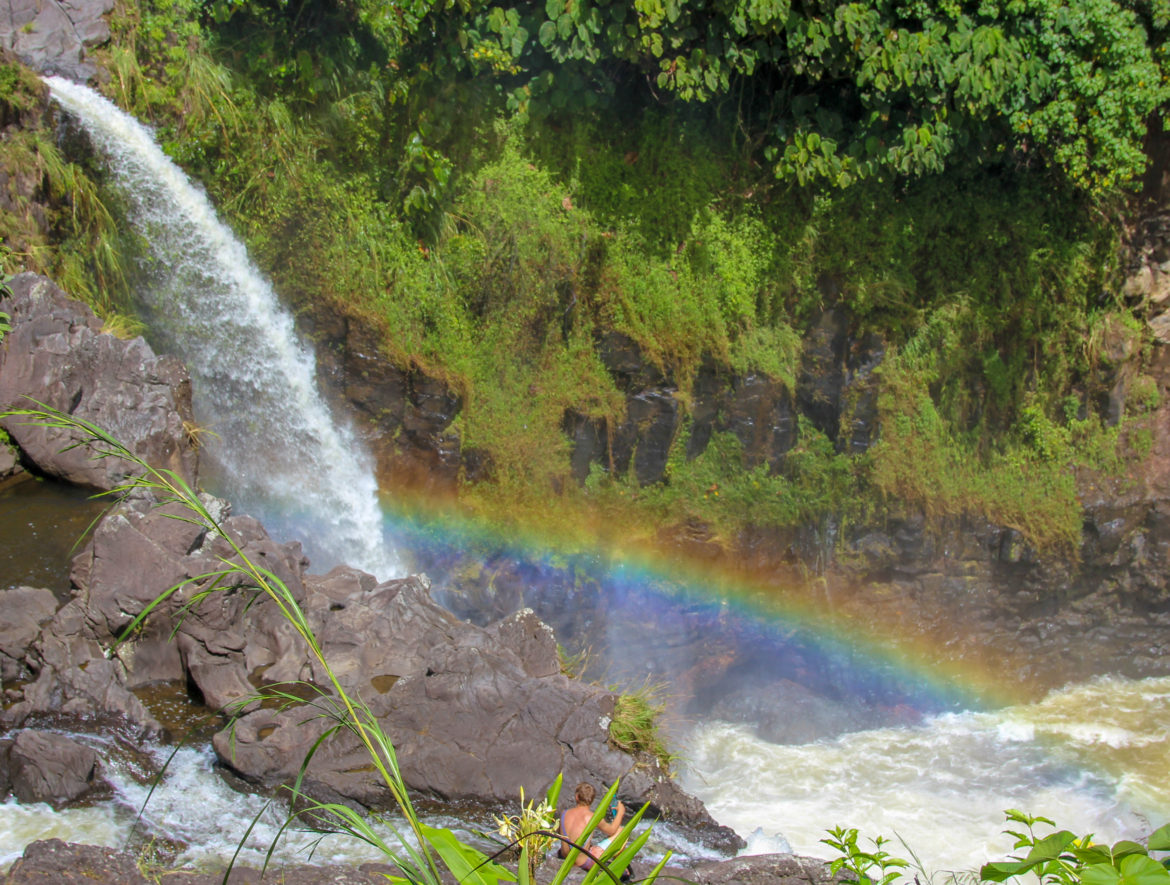Big Island Hawaii attractions are a magnificent spectrum of volcanic wonders, beaches, lush rainforests and pristine waterfalls. Read on to learn about what to see and do in this unique and stunning island at both Akaka Falls State Park and Volcanoes National Park.
The Big Island is the largest and youngest island of the Hawaiian archipelago. Overall, its diverse landscapes include sandy beaches, lush rainforests and 5 volcanoes. Hapuna Beach and Kahalu’u Beach Park in the west are popular snorkeling sites. Mauna Kea is the tallest mountain in Hawaii and tallest sea mountain in the world at 13,796 ft. Additionally, Mauna Loa is the world’s most massive shield volcano on Earth. Both Mauna Loa and Kilauea are the 2 active volcanoes in the Volcano National Park on Big Island. Mauna Kilauea is the most famous, youngest and active of Hawaii’s volcanoes. Furthermore, it continuously erupted from 1983 to 2018. Additionally, Akaka Falls State Park is home to Hawaii’s most famous waterfall.
Akaka Falls State Park
Akaka Falls State Park is home to rainforests, gorges and of course, stunning waterfalls. Named after its most beautiful waterfall, Akaka Falls, the park is a marvel. Perhaps, Akaka is the most famous waterfall in Hawaii. ‘Akaka” in Hawaiian means a split or crack. Furthermore, Akaka Falls at 442 ft (135 m) tall, cascades into a deep gorge. There are several viewing points along a loop trail, that also reveals Kahuna Falls (300 ft or 91 m) and many smaller cascades. Additionally, walking the trail’s rainforest reveals diverse flora, for example, orchids, bamboo groves and ferns.
Volcanoes National Park
Hawaii’s Volcanoes National Park protects some of the most unique geological landscapes in the world. Rising from sea level to 13,677 feet, the park is home for two of the world’s most active volcanoes: Mauna Loa and Kilauea. Furthermore, Mount Kilauea is the most famous, youngest and active of Hawaii’s volcanoes. It erupted non-stop from 1983-2018. Former images show its lava flowing into the ocean. Later, in May 2018, Mount Kilauea erupted with massive consequences and thousands of evacuations. Please note that my photos reflect my tour in 2015, three years before the most recent eruption.
My Tour included monumental stops, such as, Kilauea Visitor Center. The summit’s Halema‘uma‘u Crater, Kīlauea Iki crater and Thurston Lava Tubes. Firstly, the visitor’s center is a great start that orients yourself in the park. Here, Rangers interact and give daily updates on the conditions of the volcano, hiking information and educational tours. Also, there is a store here selling books, posters and other educational supplies.
Kīlauea Caldera – Big Island Hawaii Attractions
Located at the summit, this crater has a massive circumference of 7.85 mi (12.63 km). Furthermore, it contains Halema’uma’u, an active pit crater near the caldera’s southwestern edge.
Fun Facts: Caldera vs Crater
Craters form by the outward explosion of rocks and other materials from a volcano. In comparison, Calderas form by the inward collapse of a volcano and craters are usually more circular than calderas.
Halema‘uma‘u Craters and Kilauea Iki
The Halema’uma’u Crater is the crown of the Kilauea summit. The crater nearly doubled in size after collapsing in 2018. I took the above photo in 2015 before the collapse. Currently, the bottom of the crater lies approx. 600 m (2,000 ft) below the caldera floor. Additionally, Halema’uma’u is home to Pele, the Goddess of Fire and Volcanoes.
Kilauea Iki “Little Kilauea” Overlook
This crater is currently calm. However, in 1959, it was a dramatic lava lake, with lava fountains almost 2000 ft high. From the Overlook, the crater reveals itself as approx. a mile long, with 3,000 ft (414 m) across and the floor depth at 400 ft (122 m). Mauna Loa looms in the background. Kīlauea Iki Overlook is also the start of the Kilauea Iki Trail. This is one of the most popular trails tracing the Northern Rim of Kilauea Iki. Additionally, this trail goes to Thurston Lava Tube.
Thurston Lava Tube or Nahuku
This 600-feet long lava tube formed 500 years ago. Low viscosity lava formed a hard crust, thickening and forming a roof over the still-flowing lava. Lorrin Thurston, a local newspaper publisher discovered Nahuku in 1913.
Overall, Big Island Hawaii Attractions
This amazing island is a wild beauty that is constantly changing. Overall, the geological formations, lush rainforests, beaches and waterfalls offer the full diversity of adventurous travel. Whatever you do here, Mother Nature is the star attraction in her vast spectrum of forms.
Read More!
Wonderful Honolulu Highlights – Beaches, Monuments & Volcanoes
South Pacific’s Splendid American Samoa – A Treasure Island







